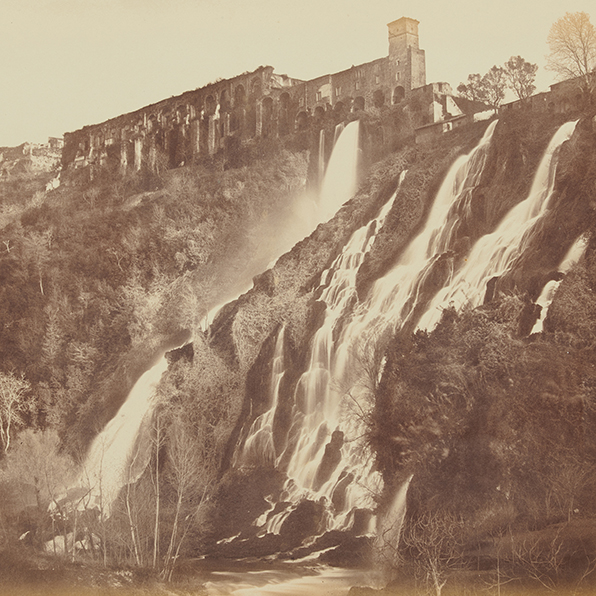Travels on Paper
November 16, 2019–February 9, 2020

Robert Macpherson
Cascatelle at the Villa of Maecenas, Tivoli
c. 1857
Collodio-albumen print
Gift of Paul Katz, 1986
The Clark Art Institute, 1986.19B
PHOTOGRAPHIC TECHNIQUES
Albumen print

John Murray (Scottish, active in India, 1809-1898), Taj Mahal from the East with Dr John Murray Seated in the Foreground with Dark Slide, 1862. Albumen print from paper negative, 14 7/16 x 18 1/16 in. Clark Art Institute, Acquired in honor of Martha Asher (Institute Registrar, 1970-1999), 1999.35.2
The most common photographic process used during the second half of the nineteenth century, the albumen print is characterized by its glossy surface. In this process, a sheet of paper is coated in a combination of ammonium or sodium chloride and fermented egg white (albumen). After coating, the paper is immersed in a bath of silver nitrate, which makes it sensitive to light. The sheet is then placed in a frame with a glass or paper negative and exposed to light. Following exposure, the paper is fixed with a sodium solution, washed in a water bath, and finally the print is dried.
Paper Negative

John Murray (Scottish, active in India, 1809-1898), Taj Mahal from the East with Dr John Murray Seated in the Foreground, 1862. Waxed paper negative, 14 7/16 x 18 1/16 in. Clark Art Institute, Acquired in honor of Martha Asher (Institute Registrar, 1970-1999), 1999.35.1
Salt Print

John Beasly Greene (American, active in the Middle East, 1832-1856), The Nile with the Theban Hills in the Background, c. 1853-54. Salt print from paper negative, 9 1/8 x 11 13/16 in. Clark Art Institute, 1998.42.4
To create a salt print, a sheet of paper is first coated with salt and silver nitrate, making it photosensitive. The sheet is then placed in contact with a negative and exposed to light. Finally, the sheet is washed, fixed, and dried. Salt prints are characterized by their hazy, soft tonality.
Gelatin Silver Print

Beverly Bennett Dobbs (American, 1868-1937), Panoramic View of Unalaska, from Seward Peninsula, Alaska, U.S.A., 1903-6. Gelatin silver print, 7 11/16 x 18 13/16 in. Clark Art Institute, Acquired with funds donated by Herbert Allen, 2000.8.4.4
The commercial development of the gelatin silver print in the 1880s revolutionized the medium of photography and ushered in the age of the amateur photographer. The process requires specially prepared paper that has been coated with a solution of silver salts in gelatin. Such paper, which also held a layer of baryta (barium sulfate), could be machine-made, omitting the need for a photographer to create emulsions to sensitize paper. When exposed to light through a negative, the treated paper produces an image. After exposure, the paper is submerged in developing solution and fixed.